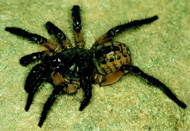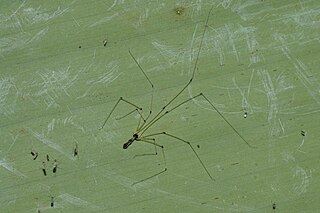
The Pholcidae are a family of araneomorph spiders. The family contains more than 1,800 individual species of pholcids, including those commonly known as cellar spider, daddy long-legs spider, carpenter spider, daddy long-legger, vibrating spider, gyrating spider, long daddy, and skull spider. The family, first described by Carl Ludwig Koch in 1850, is divided into 94 genera.

Pholcus is a genus of spiders in the family Pholcidae, with 375 described species as of January 2023.

Liphistius is a genus of basal trapdoor spiders in the family Liphistiidae. They are found in Japan, China, and Southeast Asia.

Uthina is a genus of cellar spiders that was first described by Eugène Louis Simon in 1893.

Spermophora is a genus of cellar spiders that was first described by Nicholas Marcellus Hentz in 1841.
Micropholcus is a genus of cellar spiders that was first described by Christa Laetitia Deeleman-Reinhold & J. D. Prinsen in 1987.

Belisana is a genus of cellar spiders that was first described by Tamerlan Thorell in 1898.
Calapnita is a genus of Southeast Asian cellar spiders that was first described by Eugène Louis Simon in 1892.
Khorata is a genus of Asian cellar spiders that was first described by B. A. Huber in 2005.
Tissahamia is a genus of southeast Asian cellar spiders named after Wanniyalaeto chief Uru Warige Tissahami. It was erected in 20180 for several species transferred from Pholcus after a molecular phylogenetic study of the Calapnita-Panjange clade of Pholcidae. They have long, thin abdomens that bend upward near the end. They also have six eyes, three on each of two eye stalks.
Apokayana is a genus of southeast Asian cellar spiders named after the Apo Kayan people of Indonesia and Malaysia. It was erected in 2018 for ten species transferred from Panjange after a molecular phylogenetic study of Pholcidae.
Cantikus is a genus of southeastern Asian cellar spiders first described by B. A. Huber, J. Eberle & D. Dimitrov in 2018.
Giloloa is a monotypic genus of southeast Asian cellar spiders containing the single species, Giloloa sofifi. It was first described by B. A. Huber and L. S. Carvalho in 2019, and it has only been found in Indonesia.
Kelabita is a small genus of southeast Asian cellar spiders. The genus was erected in 2018 for two species transferred from Pholcus after a molecular phylogenetic study of Pholcidae. It is named after the Kelabit, an ethnic group native to Borneo. They build domed webs up to 2 metres above the ground, and can be distinguished by unique sclerotization, including a partially sclerotized embolus. As of April 2022 it contains only two species: K. andulau and K. lambir.

Kintaqa is a genus of southeast Asian cellar spiders erected in 2018 for five species moved from Pholcus after a molecular phylogenetic study. They are medium sized spiders, distinguished by the unique enlarged shape of fourth segment of pedipalps.
Meraha is a genus of southeast Asian cellar spiders. The genus was erected in 2018 for two species transferred from Pholcus after a molecular phylogenetic study of Pholcidae. The name is derived from the Malay "merah", meaning "red", referring to the reddish-orange hue of pedipalps. They are average sized cellar spiders with a cylindrical abdomen, and they build domed webs .5 to 2 metres above the ground.
Nipisa is a genus of southeast Asian cellar spiders erected in 2018 after a molecular phylogenetic study of Pholcidae. It consists of ten Calapnita species, previously the phyllicola group of Pholcidae, now elevated to genus rank. They are pale whitish in color, with a cylindrical abdomen and relatively long legs. The name is derived from the Malay "nipis", meaning "thin", in reference to the long, thin abdomen.
Pribumia is a genus of southeast Asian cellar spiders erected in 2018 for several species transferred from Pholcus after a molecular phylogenetic study of the Calapnita-Panjange clade of Pholcidae. Six species previously in the minang group of Pholcus were transferred, but P. tahai is now in Apokayana. They have long, thin abdomens and six eyes, three on each of two eye stalks. The name is derived from the local term for Native Indonesians.
Teranga is a genus of southeast Asian cellar spiders erected in 2018 for four species transferred from Pholcus after a molecular phylogenetic study of the Calapnita-Panjange clade of Pholcidae. They are medium sized cellar spiders, averaging 3.5 to 4.5 millimetres in length, with longer legs, the first pair reaching 30 to 40 millimetres long. The abdomen is long and thin, with a slight upward bend near the end. The name is derived from the Malay "terang", meaning "bright", referring to their light color.






